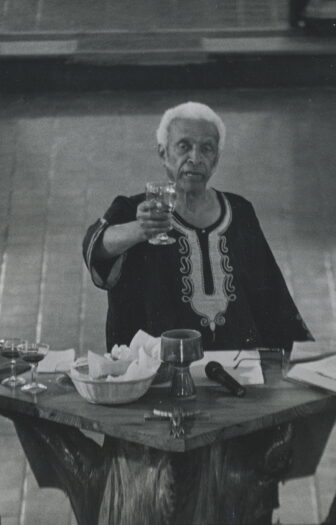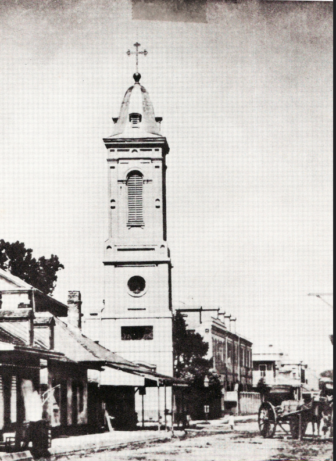Our spirituality group was assigned to tell personal stories brought to mind by Jesus’s time in the wilderness, after he was baptized, tempted by the devil and ministered to by angels. The Katrina anniversary is behind us, but I offer my story in commemoration of the recovery that dug in 10 years ago and probably will still be unfolding 10 years hence.
In a sense all of Treme, in fact all of New Orleans, was a wilderness after Katrina. But my adopted church — St. Augustine — was particularly and wrongfully under siege, cut off from its accustomed source of nourishment, the Catholic Archdiocese. And yet there were so many angels. So many vultures, too. Sometimes it’s hard to tell the difference between vultures and angels because they both swoop down at opportune moments.
St. Augustine, founded in 1841 by free people of color and slaves, is the oldest mixed-race Catholic church in the country. It didn’t flood. Its food pantry and relief services were operating full tilt in the spring after the storm. Its beloved priest, Father Jerome LeDoux, took care of anyone suffering in Treme, played the piano, worked on his memoir about the church and its history, and inspired his parishioners with sermons that soared so elegantly, you thought he might actually take to wing himself. He soldiered on during Katrina and after — a man in his 80s, sleeping on the floor, eating raw foods, as he always had, and never missing a beat.
I’m a mediator. So I can see both sides of a conflict. I’m not doing that here. You’ll get my side only, the David and Goliath version. I’d welcome someone from the archdiocese joining the discussion in the comment space below.
To me, it looked like the archbishop was presiding over a power grab, something so common after Katrina. Assigning a white priest to take over a predominantly black church smacked of jealousy, given LeDoux’s competence and popularity — jealousy tinged with resentment because LeDoux didn’t always toe the archdiocesan line with his vestments and how he ran his church. Then, when the takeover didn’t work, the archbishop tried to shut St. Augustine down.
All of us were suffering. We had lost friends and neighbors in Katrina. We were afraid of losing our city. And now the loss of our church and our priest was too much.
So let me list the angels who intervened. I list them to round out the story, to show how different they were from each other, and how unexpected. I send out waves of gratitude that today St. Augustine, against all odds, is a living, breathing parish.
The first angel is a prominent French Quarter hotelier who prefers to remain nameless here. It took us a while to make sure he wasn’t a vulture. He offered the archdiocese a donation of $1 million to settle church dues that were in arrears, an offer that was rescinded after LeDoux was ousted by his superiors.
Second was the flock of unwashed, uncouth, unchurched and anarchic revolutionaries who cleaned themselves up, put on dresses or slacks and came to church in support of LeDoux.
The choir burst into song: “Shake, shake, shake, shake the devil off.”
Third were the Golden Girls, as we called them, dignified black elders, including a woman who had never dreamed of defying Catholic authority, Joyce Montana, wife of the late Mardi Gras Indian leader Tootie Montana. These elders dressed in church clothes and placed their chairs strategically in a semi-circle at sunset to make sure the police or archdiocesan authorities didn’t try to enter the boarded-up rectory. Some parishioners and revolutionaries had seized it after LeDoux was ordered to give up his parish and sent into out-of-state exile.
Four: the Scandinavian film crew who took up residence in and around the church during Lent and Mardi Gras to make a spectacular documentary called “Shake the Devil Off.”
Five: the cooks and musicians and artists who gathered every day to provide nourishment and to constantly lift our spirits during the months-long protest.
Six: the procession of silent youngsters who passed through the mass on the Sunday of the takeover carrying signs that said, “We shall not be moved” and “Thou shalt not steal.” They hadn’t bothered to check with us adults, locked away in our endless strategy meetings. Sandra Gordon, angel No. 7, head of the parish council, was surprised to see her daughter in the lead.
Eight: Mama D, also known as Dyan French, a community organizer who takes the vocalization of black rage to the level of a high art form. Picture her on her knees (if you can) begging the white priest sent to take charge of St. Augustine not to follow orders and betray the faithful.
Let me describe the takeover in greater detail. The white priest was from a nearby church and had been instructed to celebrate mass at St. Augustine with some of his parishioners. For good measure, they arranged to be escorted by plain-clothes cops, cops packing weapons, to judge from the bulges under their suits. Asked to explain the cops, the invasive parishioners said they feared for their safety. Indeed, they were so scared that all it took was the silent march of the children to get them to beat a hasty retreat mid-service, knocking down one of their own parishioners in the street in their hurry to leave.
The choir burst into song: “Shake, shake, shake, shake the devil off.” We danced in the aisles. With LeDoux already run off by his superiors, Al Harris, angel No. 9, preached an impromptu sermon about how we are peaceable people.
Let me circle back to the boarded up rectory. It was under the direction of Suncere Ali-Shakur, all-around Katrina angel No. 10, a volunteer with the hurricane recovery collective Common Ground mentored by the group’s leader, Malik Rahim, a former Black Panther. For 20 days Suncere would lower a bucket from the second-floor window and we would load it up with chicken and other edibles. The cadre who had boarded up the doors and stuffed the locks with epoxy after LeDoux’s departure would lean out of the same window and give press conferences, prompting even Al Sharpton to come down from New York to express solidarity.
The cloistered cadre spent their free time cleaning the place up. They felt a spiritual presence — one also described by LeDoux in “War of the Pews,” his now completed book, and also by groups who visit St. Augustine’s Tomb of the Unknown Slave memorializing those early parishioners who were in bondage.
The church was closed and locked, its priest exiled to Bay St. Louis and eventually to Texas; the parish declared defunct because archdiocesan authorities said we had defiled the altar during the takeover service.
The church secretary, angel No. 11, climbed in and out of the window scarcely ruffling her perfect flip hair-do to run off flyers and keep the office going as if she still had a boss and a job.
Angel No. 12 was community activist Jacques Morial, son and brother of former New Orleans mayors, who was always there — and no telling what miracles he accomplished behind the scenes. I think he set up the mediation between St. Augustine and the archbishop conducted by angel No. 13 Ted Quant, who has since retired as director of Loyola University’s Twomey Center for Peace and Justice. The mediation worked. Despite the darkest Lent ever, by Maundy Thursday the parish was re-opened and the archbishop washed our feet.
There were many more than these 13, but with their help, resurrection was accomplished.
Orissa Arend is a mediator and psychotherapist. You can reach her at arendsaxer@bellsouth.net



